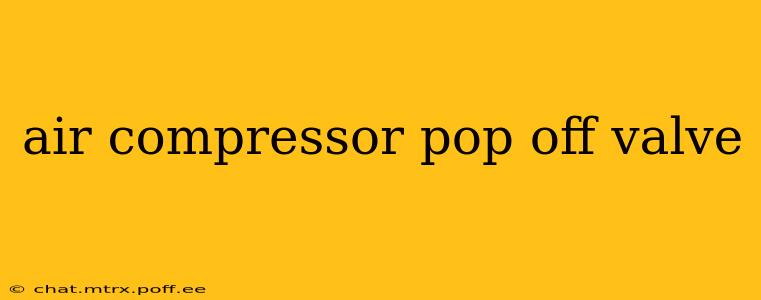An air compressor pop-off valve, also known as a pressure relief valve or safety valve, is a crucial safety feature designed to prevent dangerous pressure buildup within the compressor tank. This vital component protects both the equipment and the user from potential hazards. Understanding its function, troubleshooting common issues, and knowing when to replace it are essential for maintaining a safe and efficient compressed air system.
What is the Purpose of an Air Compressor Pop-Off Valve?
The primary function of an air compressor pop-off valve is to release excess compressed air when the tank pressure reaches a predetermined maximum. This prevents the tank from exceeding its safe working pressure, which could lead to a catastrophic rupture. The valve opens automatically when the pressure surpasses the set limit, releasing air until the pressure drops back below the threshold. This is a critical safety mechanism, making it arguably the most important part of your compressor's safety system.
How Does an Air Compressor Pop-Off Valve Work?
Most pop-off valves operate on a simple spring-loaded mechanism. A spring holds a valve disc or piston closed, resisting the pressure inside the tank. Once the tank pressure exceeds the spring's tension, the valve opens, allowing air to escape. The spring's tension determines the valve's set pressure. Some more advanced valves might use different mechanisms, but the fundamental principle remains the same: to safely release excess pressure.
What are the Signs of a Faulty Air Compressor Pop-Off Valve?
Several signs indicate that your pop-off valve might be malfunctioning. These signs warrant immediate attention:
- The valve doesn't release air when the pressure gauge shows it's exceeded the maximum safe pressure. This is the most critical sign and indicates a potential safety hazard. Immediate action is required.
- The valve leaks continuously, even when the compressor is off. A constant leak indicates a problem with the valve's seal, which needs to be addressed.
- You hear a hissing sound when the compressor is running but the pressure gauge isn't climbing. This suggests the valve is releasing air prematurely or improperly.
- The compressor shuts off frequently and unexpectedly. While this might have other causes, a malfunctioning pop-off valve could contribute to irregular shutdowns.
How Often Should I Check My Air Compressor Pop-Off Valve?
Regular inspection is crucial for maintaining safety. Check your pop-off valve at least once a month, visually inspecting it for damage, leaks, or any signs of wear. Listen carefully for any unusual hissing sounds. Consider a more frequent inspection schedule if you use your compressor heavily or in demanding conditions.
How Do I Test My Air Compressor Pop-Off Valve?
While it's generally recommended to consult your compressor's manual for specific testing instructions, a general approach involves slowly increasing the tank pressure to its maximum limit. If the valve doesn't release air at or near the rated pressure, it requires attention. Never attempt to forcefully test the valve; this could be dangerous.
What Happens If My Air Compressor Pop-Off Valve Fails?
A failed pop-off valve poses significant risks. The most serious consequence is a tank rupture due to excessive pressure buildup. This can result in serious injury or damage to property. A malfunctioning valve can also lead to inefficient compressor operation, impacting productivity and potentially causing other components to fail prematurely.
Can I Repair an Air Compressor Pop-Off Valve?
Some simple issues like minor leaks might be addressable with basic maintenance like cleaning or lubrication (always consult your manual first!), but in most cases, a faulty pop-off valve should be replaced rather than repaired. The safety implications of a faulty valve outweigh any potential cost savings from attempting a repair. Replacements are readily available from most hardware stores and online retailers, often relatively inexpensive.
How Do I Replace an Air Compressor Pop-Off Valve?
Replacing the pop-off valve usually involves disconnecting the air lines, removing the old valve, and installing the new one. Refer to your air compressor's specific instructions for detailed guidance. Always ensure the compressor is turned off and depressurized before attempting any repair or replacement.
Remember, safety is paramount when handling compressed air equipment. A properly functioning pop-off valve is essential for safe and reliable operation. Regular inspection and prompt replacement of faulty valves are crucial steps in preventing accidents and ensuring the longevity of your air compressor.
